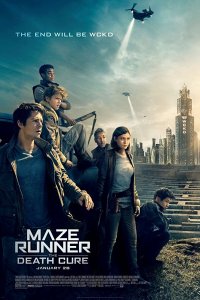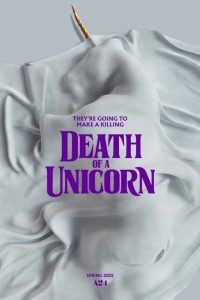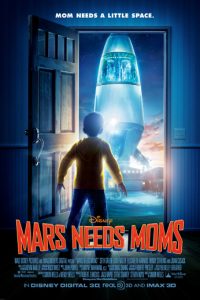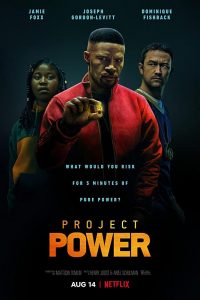The Omega Boy: A Review of Maze Runner: The Death Cure, by Gary Westfahl
 Although I haven’t read any reviews of the film, I suspect that Wes Ball’s Maze Runner: The Death Cure (simply entitled The Death Cure in the opening credits) will be praised, or condemned, as a routine action film, with a series of exciting, well-executed sequences pitting likable protagonists against impossible odds, stitched together by quieter scenes to advance its plot and develop the characters. In sum, if you like the Fast and Furious movies, you’ll probably like this one; if you are bored by such exercises, you’ll gradually grow tired of this overlong film (142 minutes), praying for it to end and disgruntled by repeated discoveries that young Thomas (Dylan O’Brien) and his beleaguered cohorts are embarking on yet another desperate mission. Still, like its precursors The Maze Runner (2014 – review here) and Maze Runner: The Scorch Trials (2015 – review here), this conclusion to Ball’s adaptations of James Dashner’s young adult trilogy does have some interesting aspects that merit some discussion, though these do not constitute a recommendation that anyone should pay to watch this film.
Although I haven’t read any reviews of the film, I suspect that Wes Ball’s Maze Runner: The Death Cure (simply entitled The Death Cure in the opening credits) will be praised, or condemned, as a routine action film, with a series of exciting, well-executed sequences pitting likable protagonists against impossible odds, stitched together by quieter scenes to advance its plot and develop the characters. In sum, if you like the Fast and Furious movies, you’ll probably like this one; if you are bored by such exercises, you’ll gradually grow tired of this overlong film (142 minutes), praying for it to end and disgruntled by repeated discoveries that young Thomas (Dylan O’Brien) and his beleaguered cohorts are embarking on yet another desperate mission. Still, like its precursors The Maze Runner (2014 – review here) and Maze Runner: The Scorch Trials (2015 – review here), this conclusion to Ball’s adaptations of James Dashner’s young adult trilogy does have some interesting aspects that merit some discussion, though these do not constitute a recommendation that anyone should pay to watch this film.
Dashner’s novel The Death Cure (2011) foregrounds an issue that has reverberated throughout the history of modern science fiction: if some future disaster is threatening to drive humanity to extinction, should scientists and officials focus their resources on trying to save everybody, even if there is little or no chance of success, or should they instead strive to protect an elite few as a way to preserve the human race and maintain our civilization? WICKED is avowedly dedicated to the first goal – finding a cure to the lethal plague called the Flare afflicting future humans – but many science fiction writers have been comfortable with the second option. One recalls that the happy ending to Philip Wylie and Edwin Baumer’s When Worlds Collide (1933), filmed in 1951, was the launch of a spaceship to rescue a small group of carefully chosen people from an Earth about to be destroyed by a collision with another planet, and in the 1980s, there emerged a large body of literature based on the premise that Earth’s best and brightest should properly abandon the lazy, decadent inhabitants of their home planet to establish their own utopias in space. And Dashner’s novel ultimately embraces this agenda: the sinister organization WICKED did justify torturing young “Immunes” who aren’t affected by the Flare because that might enable them to discover a cure, but its leader Ada Paige ultimately concludes that a cure is impossible and that all of their efforts were futile. Still, she argues that WICKED has succeeded in another way by fortuitously training a small cadre of youths with superior survival skills who can remain alive while everyone else is dying – thus aligning the novel with other science fiction novels.
In contrast, Hollywood recoils at the notion that it is all right to ignore the plight of the unwashed masses to create a paradise for a selected minority, as illustrated by the film Elysium (2013 – review here). Downsizing (2017 – review here) ultimately makes a similar argument when Matt Damon’s character is offered the opportunity to join the pioneers of the shrinking process as they isolate themselves from a doomed planet, but his girlfriend persuades him to stay behind to help the downtrodden people of her community. Without saying too much about its conclusion, T. S. Nowlin’s screenplay is innovative in trying to have it both ways: clearly striving to be faithful to the novel, he suggests that, as in the novel, Thomas and the other Immunes will ultimately settle down in their own separate society, but in deference to cinematic sensibilities, he also intimates that a universal cure might still be achieved and provided to all of the Flare’s victims.
The film departs from the novel in other predictable fashions. Throughout his trilogy, Dashner is doggedly ambivalent about the morality of WICKED’s actions: the elaborate ways they torment the Immunes regularly seem evil, or at least misguided, but the motives of its leader Ava Paige are manifestly admirable, and she maintains to the end that “WICKED is good” (the novel’s concluding phrase). But Hollywood prefers stark dichotomies between purely good and purely evil characters, so there is never any question about the overall wickedness of WICKED and the propriety of Thomas and his friends slaughtering their operatives at every opportunity. In the novel, Paige’s associate Janson only turns into an out-and-out villain when he succumbs to the Flare, but the film’s Janson (Aidan Gillen) is a dirty rotten so-and-so from the get-go.
As was already evident in Maze Runner: The Scorch Trials, Ball and Nowlin evidently thought that WICKED’s methodology in the novel – devising convoluted ordeals to alter the brains of Immunes in order to study the changes and figure out a cure – was too complicated for audiences to understand, and hence substituted the notion that their bodies contain some fluid that might function as a miracle cure; thus, WICKED wants to imprison all the Immunes to drain fluids from their bodies and test them on Flare victims. In this film, WICKED increasingly focuses on nabbing Thomas, whose fluids, they suspect, will prove especially efficacious. In this respect, Ball’s films may have been influenced by what might be regarded as the ur-film of the Zombie Apocalypse, The Omega Man (1971), wherein the blood of immune hero Charlton Heston will cure all the victims of a future plague. In an era that regularly celebrates young people as humanity’s best hope for victory against adversity, it is of course appropriate to replace the adult Heston with a teenager as our potential savior.
Maze Runner: The Death Cure emulates other contemporary films in another respect – but with a difference. Films like Elysium may express commendable concern about the fates of imperiled populations, but to resonate with audiences (it is believed), their center of attention must be valiant efforts to rescue particular characters that audiences have come to know and like. Quite often, as in War of the Worlds (2005 – review here) and Godzilla (2014 – review here), the hero is devoted almost exclusively to the safety of his family members. In the case of the Maze Runner movies, however, the youthful protagonists have been stripped of their memories and isolated in special environments, entirely cut off from their families. Hence, it is the well-being of their friends that must become the heroes’ obsession. In particular, the McGuffin driving this film’s plot is Thomas’s determination to rescue his friend Minho (Ki Hong Lee) from the clutches of WICKED – a recurring device invented by Nowlin, since the novel’s Minho is generally free to accompany Thomas on his adventures. The opening sequence involves a daring and complicated scheme to rescue some Immunes, including Minho, being transported in a train to the city where WICKED has its headquarters. (Unlike the novel, the film does not identify the city as Denver, perhaps to forestall complaints that none of its scenes were filmed in Denver, and nothing about its city – even its aged ruins – bears any resemblance to Denver. There’s even a hint that the film was actually shot in South Africa when a sign identifies an elevator as a “lift” – the British term.) Thomas thinks he has identified the car containing Minho, which is duly plucked from the train tracks and transported to safety; but he is disappointed to find that they have seized the wrong car. (I’m sure the youths in that train were heartened to learn that the mission to liberate them is now considered a failure because one favored person wasn’t in their midst.)
Presumably, if he had found Minho, Thomas would have been content to kick back and let WICKED do its evil things, but his friend’s continued imprisonment inspires his resolve to go to the city, and later penetrate WICKED’s headquarters, even though everyone around him tells him – correctly – that such a mission is absolutely insane. But his other friends – Newt (Thomas Brodie-Sangster), Frypan (Dexter Darden), Jorge (Giancarlo Esposito), Brenda (Rosa Salazar), and later Gally (Will Poulter – then insanely decide to accompany him, because hey, they are also obsessed with the safety of their friend Thomas. What was said about one character, then, might have been said about several characters: “You sorta have this problem of not walking away from people, even when you should” – or as Minho observes, “You guys are nuts.” Nevertheless, in its maniacal focus on friendship, this film may be ahead of its time; after all, people today are increasingly living by themselves, far away from their original homes and families, and are increasingly declining to get married and forge families of their own. For such individuals, their friends may indeed become their main priority in life.
Ball’s film is also following another celebrated trend in literature – “genre-blending” – in a manner that makes it resemble a video game. To be sure, unlike the original film, the characters’ experiences are never officially aspects of a game (except for Minho’s brief, drug-induced hallucination that he has been returned to the Maze). Everything that happens in the film is all too real, and our heroes go about their business in deadly earnest. (This is despite the fact that the film, unlike the novel, does have some occasional jokes, including one that actually made me laugh: when Minho is incredulous to learn that the once-adversarial Gally is now his ally, he exclaims, “I put a spear through your chest!” Gally replies, “Yeah, nobody’s perfect.”) But what makes the film really seem game-like is its refusal to choose, and settle into, a single generic model, like the futuristic horror movie Alien (1979) and its futuristic war movie sequel Aliens (1986). Instead, its filmmakers seem determined to borrow sequences from as many different sorts of action films as possible.
And this provides the film with the structure of a video game, like the classic Mario Brothers games, wherein the plucky plumber might first traverse through a garden-like level, pause briefly to watch some celebratory fireworks, and then proceed to an underground level, an aerial level, and an underwater level. Similarly, in this film, Thomas and/or his friends successfully get through an aerial acrobatics level, a Zombie Apocalypse level, a violent car chase level, an urban warfare level, and a gladiatorial combat level, among others. Perhaps Ball and Nowlin imagined that such variety would make their film lively and surprising, but since there is nothing in any of these scenes that audiences haven’t seen many times before, that is unfortunately not the case.
Frenetic borrowings from diverse genres can be a sign that the film’s foundational genre – in this case, film franchises based on young-adult dystopian novels – may be becoming exhausted. Certainly, there are signs that they are steadily losing their appeal: although all four Hunger Games films were huge successes, the declining popularity of the Divergent series led to the cancellation of a planned fourth film; a projected series based on Rick Yancey’s 5th Wave trilogy collapsed after the failure of the first film (2016 – review here); and while there were rumblings that producers would follow the precedent of the Hunger Games films and Divergent films in planning to make the final Maze Runner book into two films, the relatively modest returns from the first two films inspired the decision to end the series with a single film, and even though Dashner has recently added two prequels to the series, there are no signs of any interest in filming them. Perhaps, as the American economy gradually improves, young people are becoming less inclined to be pessimistic about the future, and less inclined to characterize themselves as the victims of evil adults. Conversely, with the rise of infectious diseases resistant to all antibiotics, and the increasing chance of a nuclear war with North Korea, it may be that grim visions of future plagues and future wars now seem unpleasantly realistic, and hence not particularly entertaining.
It is also telling that, in contrast to the well-financed Hunger Games films, the budgets for the Maze Runner films have been less generous, possibly explaining the general lack of imaginatively futuristic touches and contributing to the sense that its action sequences are derivative. The large, hovering “Bergs” are mildly innovative, though they seem a type of aircraft that we could easily build today if there was a need for them; but otherwise, future people are still traveling in the same sorts of trains, cars, and buses that we use today. The laboratories where WICKED performs its sinister experiments look very similar to modern hospital rooms, and a gun that paralyzes victims with electricity represents the film’s only distinctive weaponry (unless one counts a brief glimpse of the spider-like “Grievers” that dominated the first film, perhaps an artfully recycled clip from that film). One might argue that the emergence of a lethal plague has hindered further scientific progress, but WICKED has always flaunted its abundant resources and ability to spend whatever it takes to achieve its goals, including the development of truly advanced technology instead of minor modifications of existing technology. The absence of state-of-the-art devices does, however, serve the purposes of the plot, since it leaves WICKED with no way to defeat unarmed opponents who are clever enough to crawl through a sewer to escape detection and strong enough to knock out opponents with their fists.
The effectiveness of WICKED’s apparently outmatched opponents suggests, finally, that science may not be the answer to humanity’s problems; instead, we need to get away from our machines and return to the simple lifestyles of our ancestors – a familiar message in science fiction films. Dashner’s novel explicitly condemns science by revealing that the ruinous Flare disease was deliberately created by scientists to reduce Earth’s population, and while the film fails to point that out, WICKED’s depraved uses of science do argue against its virtues. In contrast, this film’s protagonists seem most content when they get away to a bucolic seaside village, and other futuristic films like Oblivion (2013 – review here) significantly conclude with their heroes finding happiness in rustic settings. Maze Runner: The Death Cure, then, is hardly the first science fiction film that, as the saying goes, might be more accurately characterized as an anti-science fiction film – representing yet another way that a seemingly novel film is actually failing to break new ground.
Directed by Wes Ball
Written by T. S. Nowlin, based on the novel The Death Cure (2011) by James Dashner
Starring Dylan O’Brien, Ki Hong Lee, Kaya Scodelario, Thomas Brodie-Sangster, Dexter Darden, Will Poulter, Jacob Lofland, Giancarlo Esposito, Rosa Salazar, Aiden Gillen, Barry Pepper, Nathalie Emmanuel, Katherine McNamara, Walton Goggins, Dylan Smith, and Patricia Clarkson
Gary Westfahl has published 25 books about science fiction and fantasy, including Science Fiction Quotations: From the Inner Mind to the Outer Limits (2005), The Spacesuit Film: A History, 1918-1969 (2012), A Sense-of-Wonderful Century: Explorations of Science Fiction and Fantasy Films (2012); excerpts from these and his other books are available at his World of Westfahl website. He has also published hundreds of articles, reviews, and contributions to reference books. His most recent books are the three-volume A Day in a Working Life: 300 Trades and Professions through History (2015) and An Alien Abroad: Science Fiction Columns from Interzone (2016), now available from Wildside Press; ; his forthcoming books include Arthur C. Clarke and Bridges to Science Fiction and Fantasy: Outstanding Essays from the J. Lloyd Eaton Conferences.








Haven’t read a word of the books.
I had to see the conclusion of the trilogy, because at the end of the second I was so astounded that the heroes’ plan was, basically, to go hide in the mountains til the rest of humanity died off, and forget about trying to find a cure.
It was perfectly logical that the conclusion did indeed go there. The final scene where Thomas has a single injection in his hand means he can cure one person. But without WCKD’s resources to analyze the serum, then synthesize it in bulk, that’s it. One person, and one person only. I wonder if Nowlin realized that if Thomas had been taken back to WCKD at the end of the second movie, instead of being rescued by Giancarlo Esposito’s character, then WCKD would have found the magical properties of Thomas’ blood, started a factory and saved the rest of humanity.
Instead, Thomas was directly instrumental in getting an entire city full of the people who could have manufactured the cure in mass quantities killed. Somebody or other once claimed that there was no greater love than that a man should lay down his life for his friends. This series, like Cabin in the Woods, instructs us in a higher morality, that there is no greater love than that a man should slaughter all the world for his friends.
Funny how nobody mentions the obvious huge plot hole there. Don’t you think that they would have tested the blood of the immune as a first step to figure out why they are immune? That kind of totally lazy story telling is very disappointing. Too bad because I did enjoy the movies.